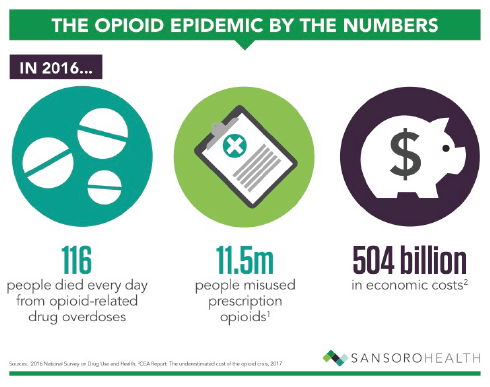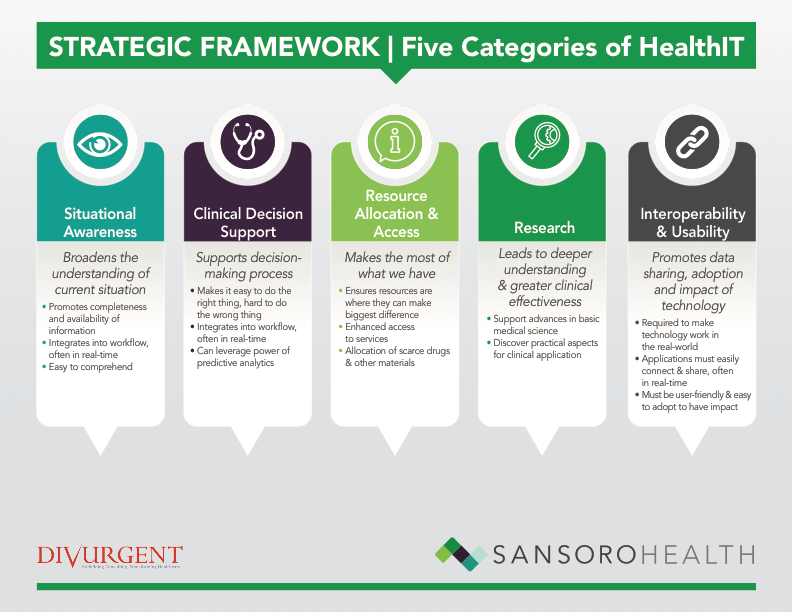by Colin Konschak, FACHE, Divurgent and Dave Levin, MD, Sansoro Health
Part One: A Strategic Framework
A Full Blown Crisis
One of the authors recently had the opportunity to participate in a multi-stakeholder workshop in Cleveland, OH dedicated to finding new, collaborative approaches to addressing the nation’s opioid abuse epidemic. While Ohio might be considered ground zero for this epidemic, the evidence is clear that this is a national crisis and it is getting worse. The numbers are frightening, especially the 2016 estimate that 2.1 million people misused opioids for the first time.

Given the statistics, it is likely that many of you have been personally touched by the epidemic. In our experience, successful improvement efforts in health care almost always address the role of people, process, and technology. Strategic innovations aimed at the opioid abuse crisis should account for all three of these in a holistic manner. Innovation should be pursued as a series of practical experiments that address current gaps, result in near-term improvement, provide insights for future tests of change, and lead to a set of sustainable and scalable solutions that will be essential to ensuring long-term success in addressing this enormous problem.
The Strategic View and and a Framework for Innovation
This is an “All Hands-On Deck” moment and health IT (HIT) has a lot to offer. The Centers for Medicare and Medicaid Services (CMS) recognized this potential when they included specific HIT requirements related to the opioid abuse epidemic in the recently published final rules for prospective payment. We will dive deeper into these new CMS requirements and their implications for HIT in the next post in this series. So where do we begin? The ONC’s Health IT Playbook provides useful examples of how Health IT tools can help in the opioid addiction crisis. Given the many different possibilities, having a method for organizing and prioritizing potential IT innovations is an important starting point. We propose a framework that groups opportunities based on an abstract view of five types of functionality.

Situational Awareness. The concept of situational awareness is often applied to high-risk, high-performance activities. Aerospace, oil refineries, and the military focus on increasing the situational awareness of personnel because it has been proven to improve safety. Core to this idea is ensuring that key information is available and that both individuals and teams can readily absorb and act on upon it. These technologies increase completeness and availability of information about specific patients, often in real-time. Prescription Drug Monitoring Programs (PDMP’s) are a good example of this technology, giving clinicians a more robust view of all the medications a patient has been prescribed regardless of prescriber or location. Clinical Decision Support. The digitalization of health care via deployment of electronic health records (EHRs) sets the stage for clinical decision support (CDS). In the broadest terms, the goal of CDS is to “make it easy to do the right thing, hard to do the wrong thing.” Often this entails real-time interaction with end-users that is integrated into their workflow. CDS can be utilized by both healthcare providers and patients. Specific examples include automated checks for interactions or allergies when a new medication is prescribed. CDS can also incorporate big data approaches like predictive analytics and pattern recognition, providing powerful tools for future enhancements. Resource Allocation and Access. This includes technologies that guide the allocation of precious resources or facilitate access to services. Given the scale of the crisis and limited resources, it is imperative that we “make the most of what we have.” This can include deploying resources where they will have the greatest impact and minimizing wasteful or ineffective activities. Examples might include access to providers for medication-assisted therapy (MAT) or managing the supply chain and distribution of medications subject to shortages. It also points towards creating better and more efficient means to access care through technologies like telemedicine. Research. Solving the opioid crisis will require a deeper understanding of its causes and the discovery and validation of new therapies and other interventions. Technologies that support epidemiology, basic medical research and clinical effectiveness evaluations will be essential on this journey of discovery. The emerging field of social determinates of health (SDH) will contribute to this understanding as well. Interoperability and Usability. Technology is useless if no one uses it, hence interoperability and ease of use are essential. Technologies like application programming interfaces (APIs) and fields like human factors engineering enable adoption and increase ease-of-use and clinical effectiveness. In effect, this category plays a supporting role for all of the categories listed above. Taking a “build it and they will come” approach rarely works. Busy clinicians working with complex patient issues need tools that are intuitive and fit their workflow.
What’s Next: Deep Dives and a White Paper
Future articles in this series we will take a deep dive into each of the above categories. We will explore in more detail the technologies that fit each category and their potential role in innovating amidst this crisis. For those with even greater interest, we have published a white paper that provides a more in-depth perspective on clinical, sociological and technical factors impacting the opioid abuse epidemic.
Download the full whitepaper – Evolving Role of Health IT in the Opioid Crisis.
About the Authors
Dave Levin, MD is the Chief Medical Officer for Sansoro Health where he focuses on bringing true interoperability to health care. Dave is a nationally recognized speaker, author and the former CMIO for the Cleveland Clinic. He has served in a variety of leadership and advisory roles for health IT companies, health systems and investors. You can follow him @DaveLevinMD or email Dave.Levin@SansoroHealth.com. Colin Konschak, FACHE is the Chief Executive Officer at Divurgent. He is a highly accomplished executive with over 20 years of experience with extensive experience in health care operations, P&L management, account management, strategic planning and alliance management. You can follow him on LinkedIn or email him at ck@divurgent.com


